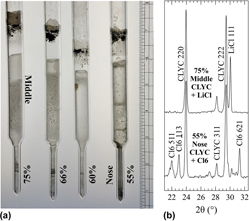Crossref Citations
This article has been cited by the following publications. This list is generated based on data provided by
Crossref.
Lin, Jia
Wei, Qinhua
Zhang, Di
Tang, Gao
Qin, Laishun
and
Shi, Hongsheng
2019.
Crystal Growth and Scintillation Properties of Non‐Stoichiometric Cs2LiLaBr6:Ce.
Crystal Research and Technology,
Vol. 54,
Issue. 10,
Zhu, Hebing
Zhang, Peng
Pan, Shangke
Li, Huanying
Jiang, Yong
Zhang, Jianyu
Zhang, Zheng
Ren, Guohao
Pan, Jianguo
and
Chen, Hongbing
2019.
Growth and characterization of Cs2LiLaCl6:Ce single crystals.
Journal of Crystal Growth,
Vol. 507,
Issue. ,
p.
332.
Ruta, Francesco L.
Lam, Stephanie
Fiala, John
Khodyuk, Ivan
and
Motakef, Shariar
2020.
Monte Carlo simulation of a Cs26LiYCl6:Ce-based composite scintillator for neutron and gamma detection.
Nuclear Instruments and Methods in Physics Research Section A: Accelerators, Spectrometers, Detectors and Associated Equipment,
Vol. 954,
Issue. ,
p.
161480.
Zhang, Xianggang
Kang, Zhe
Cai, Zhuochen
Zhai, Huiwen
Yin, Ziang
Jie, Wanqi
and
Wang, Tao
2021.
Study on the segregation behavior of Ce in CLYC crystals.
Journal of Crystal Growth,
Vol. 573,
Issue. ,
p.
126308.
Wang, Haoyu
Xiong, Jianhui
Li, Man
Geng, Jufeng
Pan, Shangke
and
Pan, Jianguo
2021.
Crystal Growth, Luminescence and Scintillation Characterizations of Cs2KLaCl6:Ce and Cs2KCeCl6.
Crystals,
Vol. 11,
Issue. 6,
p.
653.
Xu, Yongjun
Liu, Xin
Cao, Xin
Huang, Changping
Liu, Enke
Qian, Sen
Liu, Xingchen
Wu, Yanjun
Dong, Fengliang
Qiu, Cheng-Wei
Qiu, Junjun
Hua, Keqin
Su, Wentao
Wu, Jian
Xu, Huiyu
Han, Yong
Fu, Chenguang
Yin, Zhigang
Liu, Miao
Roepman, Ronald
Dietmann, Sabine
Virta, Marko
Kengara, Fredrick
Zhang, Ze
Zhang, Lifu
Zhao, Taolan
Dai, Ji
Yang, Jialiang
Lan, Liang
Luo, Ming
Liu, Zhaofeng
An, Tao
Zhang, Bin
He, Xiao
Cong, Shan
Liu, Xiaohong
Zhang, Wei
Lewis, James P.
Tiedje, James M.
Wang, Qi
An, Zhulin
Wang, Fei
Zhang, Libo
Huang, Tao
Lu, Chuan
Cai, Zhipeng
Wang, Fang
and
Zhang, Jiabao
2021.
Artificial intelligence: A powerful paradigm for scientific research.
The Innovation,
Vol. 2,
Issue. 4,
p.
100179.
Yuan, Dongsheng
Víllora, Encarnación G.
Kato, Takumi
Nakauchi, Daisuke
Yanagida, Takayuki
and
Shimamura, Kiyoshi
2022.
Ce:LaB3O6 glass for high-resolution radiation dosimetry.
Applied Physics Express,
Vol. 15,
Issue. 2,
p.
022010.
Jin, Taiguang
Hao, Shuwei
Shang, Yunfei
Lei, Zuotao
and
Yang, Chunhui
2022.
Recent Trends in Elpasolite Single Crystal Scintillators for Radiation Detection.
Crystals,
Vol. 12,
Issue. 7,
p.
887.
Zhang, Xianggang
Cai, Zhuochen
Kang, Zhe
Zhai, Huiwen
Yin, Ziang
Jie, Wanqi
and
Wang, Tao
2022.
Crystal Growth and Optimization of Cs2LiLaBr6 Scintillator via the Cs2LaBr5-LiBr Phase Diagram Construction.
IEEE Transactions on Nuclear Science,
Vol. 69,
Issue. 1,
p.
56.
Zhang, Xianggang
Cai, Zhuochen
Liu, Kejing
Liu, Jinbo
Yin, Ziang
Zhao, Qinghua
Yue, Aizhong
Luo, Fa
and
Wang, Tao
2023.
Insights into dendrite growth and phase transition during Cs2LiLaBr6 crystal growth.
Journal of Crystal Growth,
Vol. 609,
Issue. ,
p.
127136.
Zhu, Mengqi
Wang, Biao
Jia, Xinhui
Zhang, Yutong
Li, Jing
and
Wang, Jiyang
2023.
Defect Research in Cs2LiYCl6:Ce Crystal Scintillators.
Journal of Electronic Materials,
Vol. 52,
Issue. 3,
p.
1958.
Lu, Zhicen
Zhang, Yili
Zhu, Hebing
Wang, Qing
Pan, Shangke
and
Pan, Jianguo
2023.
Crystal growth and characterization of mixed elpasolite scintillators Ce:Cs2Li(LaBr6)x(YCl6)1-x (0 < x ≤ 0.4).
Radiation Measurements,
Vol. 163,
Issue. ,
p.
106933.
Ardiansyah, Ardiansyah
Heryanto, Heryanto
Sulieman, Abdelmoneim
Bradley, David A.
and
Tahir, Dahlang
2024.
Science mapping of the development of scintillator research as a neutron detection.
Radiation Physics and Chemistry,
Vol. 220,
Issue. ,
p.
111705.






